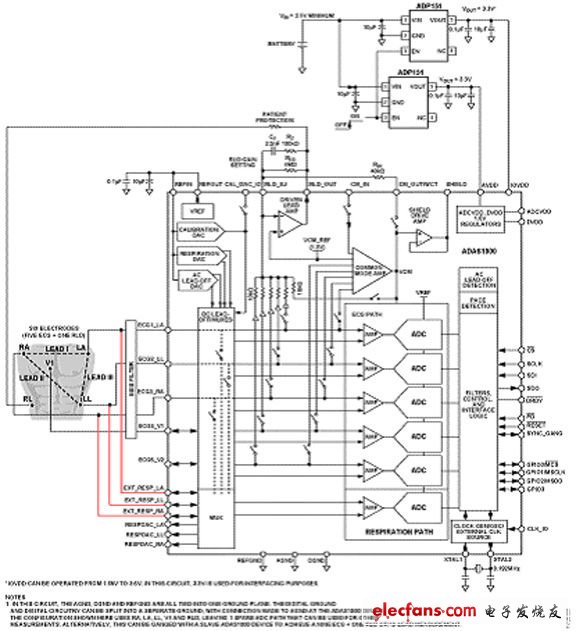This circuit is a highly integrated electrocardiogram (ECG) front end for battery-powered patient monitoring applications. Figure 1 shows a top-level block diagram of the physical connection of a typical 5-lead (4 limb leads and 1 precardiothoracic lead) ECG measurement system that integrates breathing and pulse detection functions. This configuration is commonly used for the minimum lead setting of portable telemetry ECG measurements or line-powered bedside instruments.
When measuring on the skin surface, the amplitude of the ECG signal is small, usually 1 mV. Important information about the patient's health and other parameters is contained in that small signal, so the device is required to have a measurement sensitivity of μV level. As far as the system is concerned, many medical standards require that the maximum noise does not exceed 30 μVp-p; however, designers usually set this value lower. Therefore, when designing a solution that meets system-level requirements, all noise sources must be considered.
The rated noise performance of ADAS1000 is aimed at many different working environments. The power supply must be designed to ensure that the overall performance is not reduced. The ADP151 linear regulator was chosen because of its ultra-low noise performance (9 μV rms typical, 10 Hz to 100 kHz), and the power supply rejection performance of the ADAS1000 can ensure that the noise generated by the ADP151 does not affect the overall noise performance.

Figure 1. Simplified functional block diagram of ADAS1000 for a typical 4-electrode + RLD or 5-lead configuration (all connections and decoupling not shown)
Circuit description
The ADAS1000 five-electrode ECG analog front end (AFE) solves the challenges of a new generation of low-power, low-noise, high-performance tethered and portable ECG systems.
The ADAS1000 is a highly integrated chip consisting of five electrode inputs and a dedicated right leg drive (RLD) output reference electrode. It is designed for monitoring and diagnostic-grade ECG measurements.
In addition to supporting basic components for monitoring ECG signals, the ADAS1000 is also equipped with functions such as breath measurement (chest impedance measurement), pacing artifact detection, lead / electrode connection status, and internal calibration.
A single ADAS1000 supports 5 electrode inputs, making traditional 6-lead ECG measurements easy. The second ADAS1000 slave device can be connected in parallel to adjust the system to a true 12-lead measurement (composed of 9 electrodes and 1 RLD). If multiple slave devices (3 or more) are added, the system can be adjusted The system is adjusted to 15-lead measurement and even more.
The breathing ADAS1000 integrates a digital-to-analog converter (DAC) for breath driving at a programmable frequency of 46 kHz to 64 kHz, and an analog-to-digital converter (ADC) for simplifying this complex measurement process. The measurement signal is demodulated and converted into amplitude and phase information, which can be used to determine the corresponding breathing information, thereby obtaining specific cable parameters. This circuit uses an internal capacitor with a resolution of 200 mΩ, and an external capacitor with a higher resolution (<200 mΩ). The circuit has a flexible switching scheme that allows measurement of one of the three leads (I, II, or III).
Pacing detection algorithm The pacing detection algorithm runs three digital algorithm instances on three of the four possible leads (I, II, III, or aVF). It runs on high-frequency ECG data in parallel with internal extraction and filtering. The algorithm is designed to detect and measure pacing artifacts with widths ranging from 100 μs to 2 ms and amplitudes ranging from 400 μV to 1000 mV. The ADAS1000 returns a flag to indicate whether a pacing signal is detected on one or more leads, and returns the height and width of the detected signal. When users want to run their own digital pacing algorithm, the ADAS1000 provides a high-speed pacing interface that provides ECG data at an extremely fast data rate (128 kHz), while the filtered and extracted ECG data on the standard interface remains constant.
The low-power ADAS1000 is designed for low power consumption, requiring only 21 mW to measure 5 ECG electrodes. To further reduce the overall power consumption of applications such as battery-powered dynamic electrocardiograms and telemeters, all unused channels and features can be easily disabled to further reduce the power consumption of a single ECG lead to 11 mW.
LED Tunnel Light is a special lamp used in tunnel lighting to solve the "black hole effect" or "white hole effect" ,which caused by the sudden change of vehicle brightness when entering or leaving the tunnel.
Through the softening treatment,LED tunnel light will not make the person produce dazzling or other uncomfortable reaction.
LED Tunnel Light
Waterproof tunnel light,Waterproof LED 150W tunnel light,Portable IP66 mining tunnel light,IP66 explosion-proof mining tunnel light
Jilin Province Wanhe light Co.,Ltd , https://www.wanhelight.com